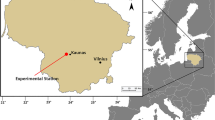Summary
Under phytotronic conditions investigations were made on the effect of important environmental factors, such as temperature, water and an increasing concentration of atmospheric CO2, on the hardening of young cereal plants.
In all the varieties derived from the major wheat growing regions of the world the hardening process was favourably influenced by a doubling of atmospheric CO2 content, so that a significantly larger number of plants survived the frost test than for plants of the same variety raised under normal conditions.
A reduction in freezing temperature and an increase in soil moisture content caused a slight reduction in survival % for varieties with excellent frost resistance and a great reduction for those with medium or poor frost resistance.
Predictions suggest that in Central Europe, as the result of global climatic changes, there will be a reduction in the quantity of winter precipitation, a considerable rise in winter temperatures and an increase in atmospheric CO2 concentration. Judging by the experimental results, these changes could improve the overwintering of winter cereals; at the same time, however, a number of factors (mainly the reduction of precipitation) leading to yield losses must be expected during the vegetation period.
Similar content being viewed by others
References
Andrews J.E., 1958. Controlled low temperature test of sprouted seeds as a measure of cold hardiness of winter wheat varieties. Can J Plant Sci 38: 1–17.
Andrews C.J., M.K. Pomeroy & I.A.De La Roche, 1974. Changes in cold hardiness of overwintering winter wheat. Can J Plant Sci 54: 9–15.
Chen, C. & L.V. Gusta, 1978. The role of water in cold hardiness of winter cereals. In: Plant Cold Hardiness and Freezing Stress, pp. 165–174. Academic Press.
Czelnai, R., Zs. Harnos & G. Szász, 1994. Éghajlativáltozás és aszály. MTA Aszálybizottság jelentése (in press).
Gusta L.V. & D.B. Fowler, 1976. Effects of temperature on dehardening and rehardening of winter cereals. Can J Plant Sci 56: 673–678.
Houghton R.A. & G.M. Woodwell, 1989. Global climate change. Sci Amer 260: 18–26.
Kimball B.A., 1983. Carbon dioxide and agricultural yield: an assemblage and analysis of 770 prior observations. WCL Report 14. Water Conservation Laboratory, Agricultural Research Service USDA, Phoenix, Arizona.
Mitchell R.C., V.J. Mitchell, S.P. Driscoll, J. Franklin & D.W. Lawlor, 1993. Effects of increased CO2 concentration and temperature on growth and yield of winter wheat at two levels of nitrogen application. Plant, Cell & Environment 16: 5, 521–529.
McKee I.F. & F.I. Woodward, 1994. The effect of growth at elevated CO2 concentrations on photosynthesis in wheat. Plant, Cell & Environment 17: 7, 853–859.
Nass H.G., 1983. Relationship between plant water content and winter hardiness of winter wheat and fall rye grown in Atlantic Canada. Can J Plant Sci 63: 67–71.
Nicolas M.E., R. Munns, A.B. Samarakoon & R.M. Gifford, 1993. Elevated CO2 improves the growth of wheat under salinity. Australian J Plant Physiol 20: 3, 349–360.
Olien C.R., 1967. Freezing stresses and survival. Ann Rev Plant Physiol 18: 387–408.
Rajki E., 1980. Winter hardiness. Frost resistance. Acta Agronomica Academiae Scientiarum Hungaricae 29: 451–468.
Roberts D.W.A. & M.N. Grant, 1968. Changes in cold hardiness accompanying development in winter wheat. Can J Plant Sci 48: 369–376.
Siminovitch D., F. Gfeller & B. Rheaume, 1967. The multiple character of the biochemical mechanism of freezing resistance of plant cells. Cellular injury and resistance in freezing ogranisms. Proc Int Conf Low Temp Sci, Hokkaidó, Univ (Sapporo) 2: 93–117.
Smart D.R., N.J. Chatterton & B. Bugbee, 1994. The influence of elevated CO2 on non-structural carbohydrate distribution and fructan accumulation in wheat canopies. Plant, Cell & Environment 17: 4, 435–442.
Tischner T., 1981. The simulation of environmental conditions in the Martonvásár Phytotron. In: K. Unger & G. Stöcker (Eds). Biophysikalische Ökologie und Ökosystemforschung, pp. 185–190. Akademie-Verlag, Berlin.
Thompson G.B. & F.I. Woodward, 1994. Some influences of CO2 enrichment, nitrogen nutrition and competition on grain yield and quality in spring wheat and barley. J Exp Bot 45: 276, 937–942.
Tyler N.J., L.V. Gusta & D.B. Fowler, 1981. The effect of a water stress on the cold hardiness of winter wheat. Can J Bot 59: 1717–1721.
Veisz, O. & J. Sutka, 1991. Frost resistance studies with wheat in natural and artificial conditions In: Proceedings of International Symposium, Wheat Breeding Prospects and Approaches, pp. 12–17. Albena, Bulgária.
Veisz, O. & T. Tischner, 1989. Frost resistance research with winter wheat in the Martonvásár Phytotron. In: Abstract of International Conf Environmental Res with Plants in Closed Chambers. p. 82. München.
White R.R., 1992. The road to Rio or the global environmental crisis and the emergence of different agendas for rich and poor countries. The International Journal of Environmental Studies 41: 187–201.
Author information
Authors and Affiliations
Rights and permissions
About this article
Cite this article
Veisz, O., Harnos, N., Szunics, L. et al. Overwintering of winter cereals in Hungary in the case of global warming. Euphytica 92, 249–253 (1996). https://doi.org/10.1007/BF00022852
Issue Date:
DOI: https://doi.org/10.1007/BF00022852




